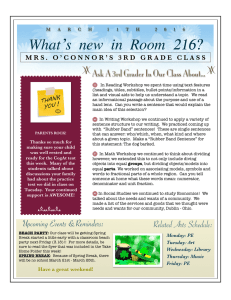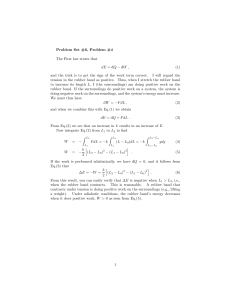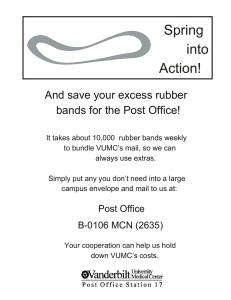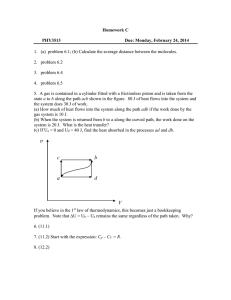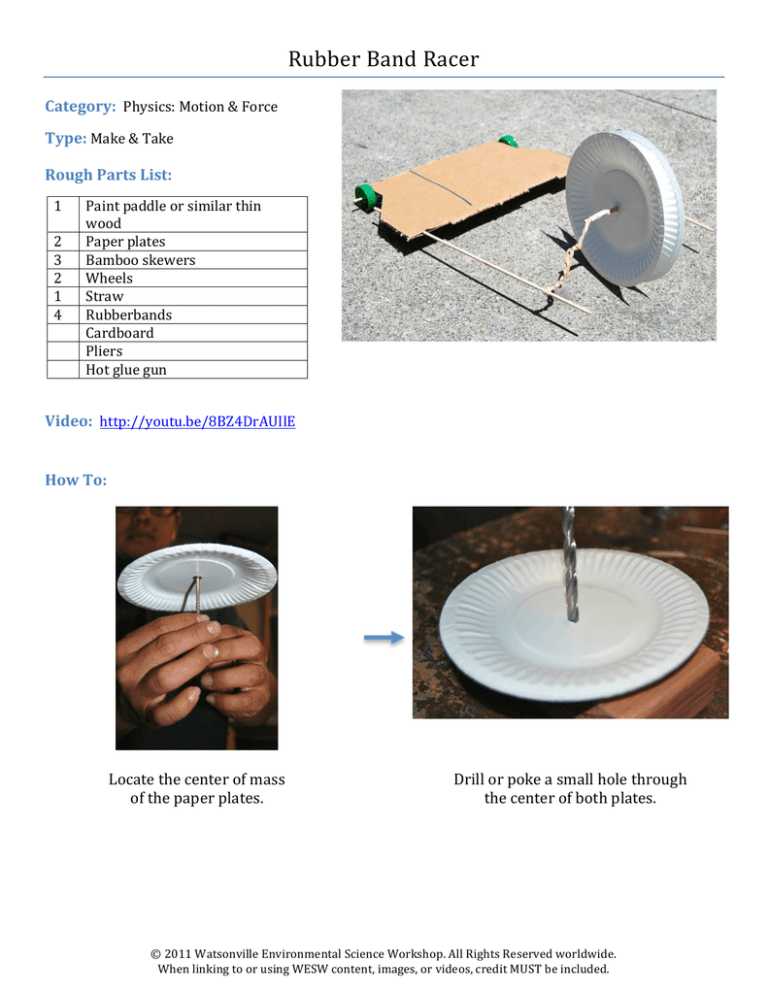
Rubber Band Racer Category: Physics: Motion & Force Type: Make & Take Rough Parts List: 1 2 3 2 1 4 Paint paddle or similar thin wood Paper plates Bamboo skewers Wheels Straw Rubberbands Cardboard Pliers Hot glue gun Video: http://youtu.be/8BZ4DrAUIlE How To: Locate the center of mass of the paper plates. Drill or poke a small hole through the center of both plates. © 2011 Watsonville Environmental Science Workshop. All Rights Reserved worldwide. When linking to or using WESW content, images, or videos, credit MUST be included. Glue the plates together back to back. Clip off the sharp points of the skewers. Cut around 3.5” of skewer and mark the center. Connect 2 rubberbands by looping one under the other. Pull the two rubber bands away from each other to form a knot. Continue to connect all 4 rubber bands, with a total of 3 knots. © 2011 Watsonville Environmental Science Workshop. All Rights Reserved worldwide. When linking to or using WESW content, images, or videos, credit MUST be included. Place the center knot to the side of the center mark on the bamboo skewer and tape the rubber bands to the skewer. Thread the rubber band skewer through the hole in the plates. Find the centerline of the skewer and glue the skewer to the plates. Glue a craft stick onto cardboard. Cut corners off the cardboard. Glue a straw onto the craft stick. © 2011 Watsonville Environmental Science Workshop. All Rights Reserved worldwide. When linking to or using WESW content, images, or videos, credit MUST be included. Drill or punch a hole through the center of each wheel. Push wheels onto each end of the skewer and attach them using a hot glue gun. Trim any excess skewer that sticks out beyond the wheel. Push one end of each remaining skewer into the cardboard. Glue the skewers to the cardboard. Loop each end of the rubber band as shown. © 2011 Watsonville Environmental Science Workshop. All Rights Reserved worldwide. When linking to or using WESW content, images, or videos, credit MUST be included. Thread the end of each skewer through the looped rubber band. Wind up the rubber band and watch your racer move! Decorate it if you like. Fine Points: → It takes a lot of winding to get the car to really take off. → The longer the rubber bands, the more energy they will hold as you wind them up. They can be a bit loose as you start twisting them. → If your floor is slick the car may spin out at the beginning. You can add weight to it to increase the friction. Concepts Involved: •
If something that is not moving starts to move, that means there is energy being used. •
Energy can be stored by twisting a rubber band. This kind of energy is called “potential energy.” •
Energy that is moving is called “kinetic energy.” When the car is moving, it has kinetic energy. •
This car, like all cars, goes forward by pushing back on the ground. Elaboration: Everything that moves follows Newton’s third law: for every action there is an equal and opposite reaction. For boats this is easier to see, because when you push off the water to make the boat go forward, you can see the water going backward. The water going backward is the action and the boat going forward is the reaction. This is hard to see with a car because you can’t see the road going backwards when the car is going forward. It is easier to see if you try to jump forward or backward off a © 2011 Watsonville Environmental Science Workshop. All Rights Reserved worldwide. When linking to or using WESW content, images, or videos, credit MUST be included. skateboard. You may go a little bit forward or backward, but the board also goes flying in the opposite direction. If there is no friction between a wheel and the ground, the wheel will not be able to put an action – or force – on the ground. This happens in real life when there is ice or mud on the road. The wheels spins, but the car does not go forward. This also happens when it’s time to stop. The wheel must have friction with the road to be able to stop, but there is low or no friction, as in the case of ice or mud, the car will keep going. To make the car go farther, wind the rubber bands more. If you make a very wide car, you can install longer rubber bands. You can also install larger rubber bands, but if the car has too much force, it will not have enough friction with the ground and it will just spin its wheels. You can solve that problem by increasing the weight of the car, which will increase the friction. Energy can be stored in a spring, and the rubber band is a sort of a spring. Rubber is made from molecules that can deform a lot before they break. When they get deformed, such as when you stretch or twist a rubber band, molecular forces try to reshape them. In this way, you can store energy in rubber. Many materials have this property, but few can stretch as far as rubber without breaking. In this project you can follow the energy step by step. We’ll start at the end and work backward. When the car stops moving, it has lost all its energy. When it was still moving, it had energy of motion, called kinetic energy. Before it began moving it had no kinetic energy, but since the rubber band was twisted tightly, it held potential energy. As you wound the rubber band up, you and the can had kinetic energy and steadily gave the rubber band potential energy. Before you picked up the car, you had potential energy in your body. This energy was stored in your cells in the form of chemical bonds. This energy came from the food you ate. The food was either from plant or animal. If it was from an animal, it got its energy from a plant, just like you. The plants in turn got their energy from the sun through photosynthesis. So, in some respect, this is a solar powered car. If you trace the energy in most things, you can trace it back to the sun. Real cars use gas, which came from plant matter tens of millions of year ago. Those plants also got their energy from the sun. The sun gets its energy from nuclear reactions – the splitting and forming of the nuclei of dozens of atoms. These atoms in turn got their energy in the formation of the universe. © 2011 Watsonville Environmental Science Workshop. All Rights Reserved worldwide. When linking to or using WESW content, images, or videos, credit MUST be included. Focus Questions: 1. How could you make a rubber band powered car go further? 2. Where did this car get its energy? 3. Where does a real car get its energy? Links to k-­‐12 CA Content Standards: Grades k-­‐8 Standard Set Investigation and Experimentation Scientific progress is made by asking meaningful questions and conducting careful investigations. As a basis for understanding this concept and addressing the content in the other strands, students should develop their own questions and perform investigations. Grades k-­‐12 Mathematical Reasoning: 1.0 Students make decisions about how to approach problems: 1.1 Analyze problems by identifying relationships, distinguishing relevant from irrelevant information, sequencing and prioritizing information, and observing patterns. 1.2 Determine when and how to break a problem into simpler parts. 2.0 Students use strategies, skills, and concepts in finding solutions: 2.1 Use estimation to verify the reasonableness of calculated results. 2.2 Apply strategies and results from simpler problems to more complex problems. 2.3 Use a variety of methods, such as words, numbers, symbols, charts, graphs, tables, diagrams, and models, to explain mathematical reasoning. 2.5 Indicate the relative advantages of exact and approximate solutions to problems and give answers to a specified degree of accuracy. 3.0 Students move beyond a particular problem by generalizing to other situations: 3.1 Evaluate the reasonableness of the solution in the context of the original situation. 3.2 Note the method of deriving the solution and demonstrate a conceptual understanding of the derivation by solving similar problems. 3.3 Develop generalizations of the results obtained and apply them in other circumstances. Grade 2 Standard Set 1. Physical Sciences: The motion of objects can be observed and measured. 1.a Students know the position of an object can be described by locating it in relation to another object or to the background. 1.b Students know an object’s motion can be described by recording the change in position of the object over time. 1.c Students know the way to change how something is moving is by giving it a push or a pull. The size of the change is related to the strength, or the amount of force, of the push or pull. 1.d Students know tools and machines are used to apply pushes and pulls (forces) to make things move. Grade 3 Standard Set 1. Physical Sciences (Energy & Matter): 1.c Students know machines and living things convert stored energy to motion and heat. 1.d Students know energy can be carried from one place to another by waves, such as water waves and sound waves, by electric current, and by moving objects. © 2011 Watsonville Environmental Science Workshop. All Rights Reserved worldwide. When linking to or using WESW content, images, or videos, credit MUST be included. Grade 8 Standard Set 2. Forces: Unbalanced forces cause changes in velocity. 2.a Students know a force has both direction and magnitude. 2.c Students know when the forces on an object are balanced, the motion of the object does not change. 2.e Students know that when the forces on an object are unbalanced, the object will change its velocity (that is, it will speed up, slow down, or change direction). 2.f Students know the greater the mass of an object, the more force is needed to achieve the same rate of change in motion. Grade 9-­‐12 Physics Standard Set 1. Motion & Forces Newton’s laws predict the motion of most objects. 1.b Students know that when forces are balanced, no acceleration occurs; thus an object continues to move at a constant speed or stays at rest (Newton’s First Law). 1.d Students know that when one object exerts a force on a second object, the second object always exerts a force of equal magnitude and in the opposite direction (Newton’s Third Law) 1.f Students know applying a force to an object perpendicular to the direction of its motion causes the object to change direction but not speed. © 2011 Watsonville Environmental Science Workshop. All Rights Reserved worldwide. When linking to or using WESW content, images, or videos, credit MUST be included.

